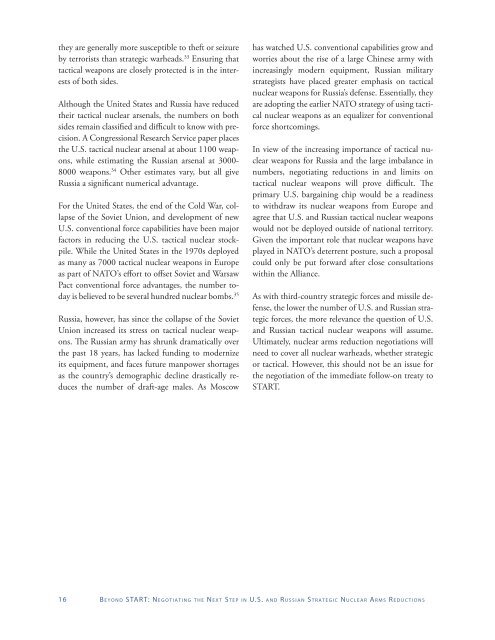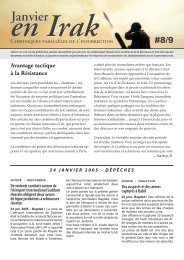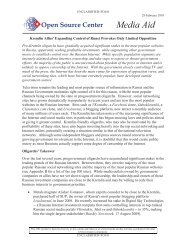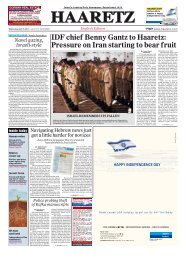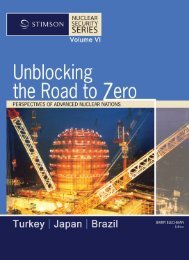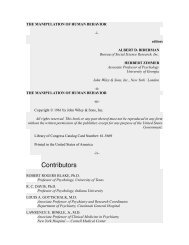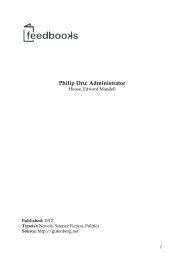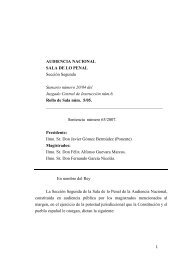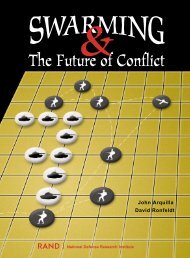As President Obama said in Prague on April 5, as thenuclear reductions process proceeds, the United States“will seek to include all nuclear weapons states in thisendeavor.” 28 That said, the United States and Russiashould be able to reduce to 1500, or even 1000, deployedwarheads on each side without having to getinto the complex subject of addressing limits on thirdcountrystrategic forces. At some point below 1000warheads, however, account of third-country forceswill have to be made. 29 This could be done by applyingseparate constraints to those countries’ forces orby multilateralizing the U.S.-Russian strategic nuclearnegotiations process. This should be an issue for thefuture, not for the U.S.-Russian negotiation in thecoming months on the <strong>START</strong> follow-on treaty.Missile DefenseU.S. and Russian strategic offensive ballistic missileforces and missile defense are related, in that effectivestrategic missile defenses deployed by one countrycould diminish the other’s strategic offensive capability.The first U.S.-Soviet agreement limiting strategicforces, the 1972 Interim Agreement on Strategic OffensiveForces, was accompanied by the ABM Treaty,which limited anti-ballistic missile systems. The reasoningfor pairing the two agreements and constrainingmissile defenses was concern that, in a crisis, oneside might have a greater incentive to strike first,believing its missile defense systems could cope witha degraded retaliatory strike. Restrictions on missiledefenses were seen as reducing incentives for buildingmore offensive ballistic missiles.Despite the attention and resources given to PresidentReagan’s Strategic Defense Initiative in the early1980s and efforts since then, effective defense againststrategic offensive missiles remains a very challengingproposition. 30 The <strong>START</strong> and SORT agreementswere signed in 1991 and 2002 without reference tolimits on missile defense. Indeed, SORT was signedfive months after the Bush administration gave noticeof its intention to withdraw from the ABM Treaty.However, as U.S. and Russian strategic offensiveforces are reduced, missile defense will assume greaterrelevance. Missile defense—particularly the Bush administrationplan to deploy ten missile interceptorsand a missile defense radar in Poland and the CzechRepublic—has been a major problem on the U.S.-Russian agenda. Presidents Obama and Medvedev onApril 1 acknowledged their differences on this issue;they also agreed that the relationship between offensiveand defensive arms would be discussed. 31There is a point below which one side or the otherwill not be prepared to reduce its strategic forceswithout somehow dealing with the missile defensequestion. Russian Duma member (and former DeputyDefense Minister) Andrey Kokoshin believes thesides are already at that point. He has called for takingU.S. missile defenses into account in the new negotiations,stating “Today, when the matter involvesmore significant limitations and reductions of offensivearms, the ABM factor becomes more weightyand prominent.” 32 Other Russian analysts have suggestedthat the sides could each reduce to 1500 strategicwarheads without addressing missile defense,but deeper reductions below that would require someconstraints in the missile defense area.Given the short time until December, it would bebest to keep missile defense limits out of <strong>START</strong> follow-onnegotiation. Were the U.S. and Russian negotiatorsto have to tackle missile defense as well as theissues associated with the follow-on treaty, it wouldbe impossible to have a new agreement in time. Itshould be possible to reduce U.S. and Russian strategicforces to 1500, and perhaps even 1000, warheadswithout agreeing beforehand or in parallel on constraintson missile defense. But this issue, as that ofthird-country strategic forces, will at some point haveto be addressed if further reductions are to be negotiatedin U.S. and Russian strategic forces.Tactical Nuclear WeaponsIn addition to strategic weapons, the United Statesand Russia each maintain sizeable arsenals of tacticalnuclear warheads. These normally have smaller explosiveyields than strategic nuclear warheads, but theprimary distinction between the two is the range oftheir delivery systems. One other concern is relatedto the safety and security of tactical nuclear warheads:Fo r e i g n P o l i c y at Bro o k i n g s 15
they are generally more susceptible to theft or seizureby terrorists than strategic warheads. 33 Ensuring thattactical weapons are closely protected is in the interestsof both sides.Although the United States and Russia have reducedtheir tactical nuclear arsenals, the numbers on bothsides remain classified and difficult to know with precision.A Congressional Research Service paper placesthe U.S. tactical nuclear arsenal at about 1100 weapons,while estimating the Russian arsenal at 3000-8000 weapons. 34 Other estimates vary, but all giveRussia a significant numerical advantage.For the United States, the end of the Cold War, collapseof the Soviet Union, and development of newU.S. conventional force capabilities have been majorfactors in reducing the U.S. tactical nuclear stockpile.While the United States in the 1970s deployedas many as 7000 tactical nuclear weapons in Europeas part of NATO’s effort to offset Soviet and WarsawPact conventional force advantages, the number todayis believed to be several hundred nuclear bombs. 35Russia, however, has since the collapse of the SovietUnion increased its stress on tactical nuclear weapons.The Russian army has shrunk dramatically overthe past 18 years, has lacked funding to modernizeits equipment, and faces future manpower shortagesas the country’s demographic decline drastically reducesthe number of draft-age males. As Moscowhas watched U.S. conventional capabilities grow andworries about the rise of a large Chinese army withincreasingly modern equipment, Russian militarystrategists have placed greater emphasis on tacticalnuclear weapons for Russia’s defense. Essentially, theyare adopting the earlier NATO strategy of using tacticalnuclear weapons as an equalizer for conventionalforce shortcomings.In view of the increasing importance of tactical nuclearweapons for Russia and the large imbalance innumbers, negotiating reductions in and limits ontactical nuclear weapons will prove difficult. Theprimary U.S. bargaining chip would be a readinessto withdraw its nuclear weapons from Europe andagree that U.S. and Russian tactical nuclear weaponswould not be deployed outside of national territory.Given the important role that nuclear weapons haveplayed in NATO’s deterrent posture, such a proposalcould only be put forward after close consultationswithin the Alliance.As with third-country strategic forces and missile defense,the lower the number of U.S. and Russian strategicforces, the more relevance the question of U.S.and Russian tactical nuclear weapons will assume.Ultimately, nuclear arms reduction negotiations willneed to cover all nuclear warheads, whether strategicor tactical. However, this should not be an issue forthe negotiation of the immediate follow-on treaty to<strong>START</strong>.16 B e y o n d <strong>START</strong>: Negotiating the Nex t Step in U.S. and Russian Strategic Nuclear Arms Reduc t i o n s


